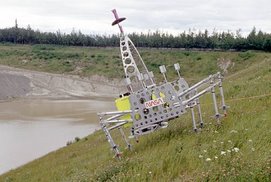It may not be long before swarms of tiny mobile robots will be giving a hand to the nurses and medical orderlies in hospitals. Wednesday, January 31, 2007 will see the launch of a new EU project led by the Fraunhofer Institute for Industrial Engineering IAO.
There is always plenty to do in a hospital, and more often than not, the staff is overworked. “This is where robots can be a real help,” explains IAO scientist Thomas Schlegel, who is coordinating the new EU project IWARD. The abbreviation stands for ‘intelligent robot swarm for attendance, recognition, cleaning and delivery’. “These robots could take over a wide range of tasks: find the doctor, call the nurse, keep the sick-room clean, and show visitors the way. What is more, the mobile assistants can also tell when help is needed in a sick-room, for instance when a patient has suffered a fall. Then they can alert a nurse or an orderly.”
Ten teams of researchers from Germany and seven other countries will collaborate on this project. They all met on Wednesday for the official project launch in Stuttgart. Over the next three years they plan to cooperate in developing a team of robots to support hospital staff. At the end of that period, the little fleet will be tested in hospitals. “What’s really new about these robots is their decentralized intelligence: Each one can act autonomously, but is also constantly in touch with its ‘colleagues’. This creates a swarm with abilities that far exceed those of each individual member,” explains Schlegel.
First example: Supposing robot number one is crossing a corridor and sees an orderly heading for a room that robot number two happens to be cleaning. In this case robot 1 can pass the information to robot 2, which can quickly retreat into a corner to make room for the orderly. Second example: Robot number one is in a cardiac patient’s room. The nurse urgently needs to consult a cardiologist. She can use the robot to broadcast a search message that is received by all members of the squad. As soon as a member of the swarm has found the doctor, it sets up a video conference with robot 1. In this way, the cardiologist is immediately put in touch with the sick-room where his advice is needed.
The robots are to be made as small and versatile as possible, ideally measuring not more than 50 by 50 by 50 centimeters. They will be equipped with a motor and wheels, an on-board computer, a radio module, optical sensors, loudspeakers, a monitor, and cleaning tools for wiping up spills and disinfecting. “All of these components already exist. The important thing for us is not having new hardware, but advancing the development of swarm intelligence,” Schlegel declares. “Our goal is to develop a program that is both powerful and extremely flexible. For example, the robots need to recognize when they are approaching sensitive equipment such as a CT scanner. They must not transmit radio signals there, as these would interfere with the imaging system. The robots can only operate autonomously in such places. Not until they have left the sensitive zones can they re-establish contact with the swarm via WLAN or Bluetooth.”
In the test phase at the end of the project, three or four robots will be sent for practical testing to each of four different hospitals – and so for a few weeks, the swarm will support hospital staff in England, Spain, France and Turkey. Initially, the robots’ duties will be restricted to cleaning and communications. In the long run, however, their decentralized intelligence holds much greater potential, says Schlegel: “Hospital processes are organized centrally at present, but decentralized data administration is perfectly feasible – be it for assignment of beds, for purchasing logistics, for planning the use of operating theaters, or for providing visitor information. Another of our goals in the EU project will be to find out how efficient the system is, and what new opportunities it opens up.”
Subscribe to:
Post Comments (Atom)







No comments:
Post a Comment